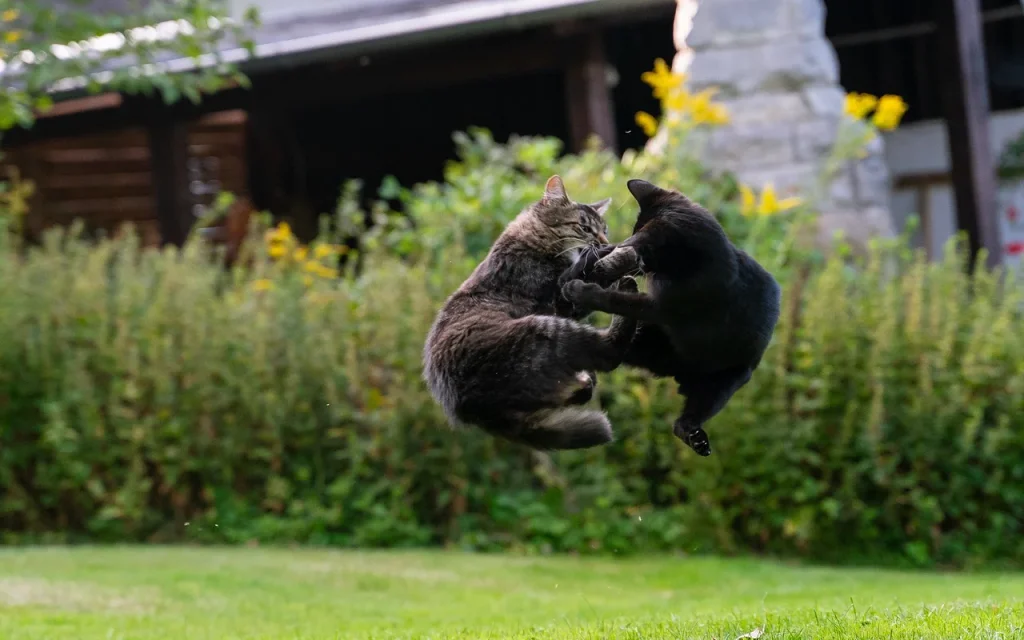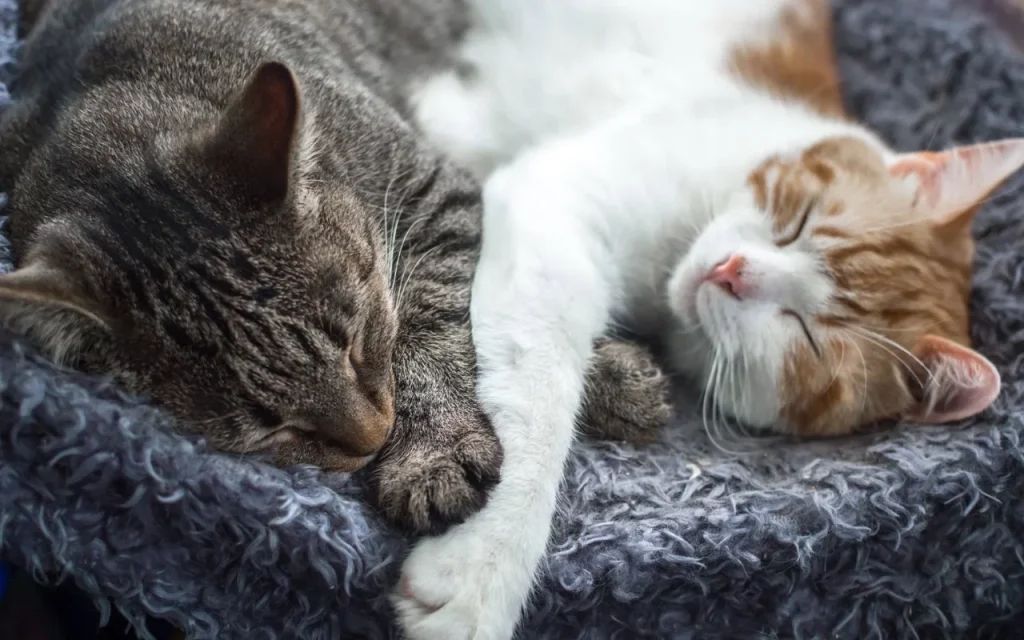You’re relaxing at home, all is peaceful, and then suddenly – a bloodcurdling yowl, a streak of fur, and that awful thumping sound of a full-blown catfight erupting. Your heart leaps into your throat, right? If you live with more than one cat, chances are you’ve experienced this distressing scene at least once, and it can leave everyone feeling shaken, including you. “Why on earth are they doing this?” you probably wonder, “I thought they were friends (or at least tolerated each other!).”
As a vet, I can tell you that cat fights in a household are a really common, and very upsetting, problem that owners bring to us. It’s tough to see our beloved feline companions at odds. But here’s the thing: cats rarely fight for no reason at all, even if the trigger isn’t immediately obvious to us humans. They’re often communicating something pretty important, in their own very feline way, about their needs, their feelings, or their environment.
So, let’s have a calm, understanding chat about some of the main reasons why our cats might end up in a brawl – we’ll touch on at least eight key areas – and then, most importantly, explore some vet-approved ways to help bring peace back to your home and stop the fighting.
Decoding the Meow-tial Arts: Why the Fur Might Be Flying

Figuring out the “why” behind the fighting is the absolute first step to resolving it. It’s like being a bit of a detective. Here are some of the usual suspects that vets and cat behavior folks often point to:
- It’s All About “My Space!” (Territorial Tussles): Cats, even our cuddly house panthers, can be incredibly territorial. They have their perceived patch – their favorite napping spot, their view from the windowsill, their path to the food bowl – and if another cat encroaches on what they consider their turf, especially if resources feel a bit scarce, a fight can break out. This is super common when a new cat is introduced, or when a young cat reaches social maturity and starts to, shall we say, assert themselves a bit.
- The “Boys Will Be Boys” (and Sometimes Girls Too!) Factor (Status & Social Stuff): Sometimes, especially with unneutered male cats, fights can be about establishing dominance or social ranking – that classic inter-male aggression. But even spayed/neutered cats, both male and female, can have squabbles as they try to figure out their relationship and who’s who in the household pecking order. This status-related aggression can sometimes be quite subtle, with lots of staring and body blocking, but other times it can definitely escalate.
- “Don’t Mess With My Kittens!” (Mama Bear Mode): If you have a mother cat with her kittens, she will, quite rightly, be fiercely protective. This maternal aggression means she might lash out at any other cat (or even people she doesn’t know well) who she thinks is getting a bit too close to her precious babies. It’s pure instinct.
- Oops, Playtime Got Way Too Real! (Play That Goes Wrong): Kittens and young cats, especially, learn how to “play nice” through rough-and-tumble games with their littermates. But sometimes, that play aggression can get a bit out of hand, especially if one cat is bigger or more boisterous, or if they just haven’t quite learned to pull their punches (or sheathe their claws!). One minute it’s fun, the next someone’s genuinely upset and a real fight erupts.
- The Wrong Target (Redirected Frustration): This one is a bit of a mind-bender but so common! Imagine your cat is sitting at the window, and they see a strange cat strutting through their garden. They get all riled up, super agitated, full of hunting or defensive hormones… but they can’t get to that outside cat. So, what happens? They turn around and lash out at the first available target – which is often your other, completely innocent, housemate cat who just happened to be walking by. That’s redirected aggression, and it can seem to come out of absolutely nowhere.
- “I’m Scared!” (Fear-Based Fighting): If a cat feels threatened, cornered, or like they can’t escape a situation that’s making them anxious, they might lash out defensively. This fear-induced aggression is just them trying to protect themselves when they feel they have no other option.
- “Ouch, That Hurts – Leave Me Alone!” (Pain Can Make Anyone Grumpy): This is a really important one. If a cat is in pain – maybe they have arthritis, a sore tooth, an injury you haven’t noticed, or some other underlying medical issue – they can become much more irritable and less tolerant of other cats (or even people) being close to them. That grumpiness can easily spill over into a fight if another cat approaches them or tries to play when they’re just not feeling up to it. This is pain-induced aggression.
- Just Plain Overstimulated or Irritable: Sometimes, just like us, cats can get overstimulated or just be in a grumpy mood, and if another cat pushes their buttons at the wrong moment, a spat can occur.
Ceasefire! Gentle Ways to Broker Peace Between Your Cats (And What to Do Right Now)
So, the fur has just flown. What do you do in the heat of the moment, and then immediately afterwards?
- Break It Up (Safely!): Your first instinct might be to dive in, but please don’t! You could get seriously scratched or bitten. Instead, try to startle them out of it with a loud, sudden noise – clap your hands loudly, shout “HEY!”, or even bang a pot. A quick squirt from a water pistol (if you happen to have one handy and it doesn’t terrify them into next week) can sometimes work too. Another option is to quickly slide a big piece of cardboard or a cushion between them to break their line of sight. The aim is to interrupt the fight without putting yourself in the middle.
- Separate the Fighters (Time Out Needed): Once they’ve disengaged, you need to separate them completely. Put them in different rooms with their own food, water, and litter box. They need time to calm right down – this can take several hours, or even a full day. Don’t try to force them back together too soon.
- Check for Injuries: Once everyone is calm (including you!), gently check both cats for any scratches, bite wounds, or signs of limping. Even small wounds can get infected, so if you see anything, it’s best to get it checked by your vet.
- Deep Breath, Detective Time: When things have settled, try to think about what might have triggered the fight. Was it over a favorite toy? A sunny spot? Did one cat startle the other? Understanding the trigger is a huge step towards preventing it next time.
Building a Harmonious Home: Long-Term Harmony & Preventing Future Fights

Okay, so you’ve managed the immediate aftermath. Now, how do we try and stop it from happening again? This is where the real work, and often a lot of patience, comes in.
- First Stop: Your Vet! This is crucial, especially if the fighting is new or has suddenly gotten worse. Your vet will want to give both cats a thorough check-up to rule out any underlying medical problems, especially pain, that could be making one (or both) of them more irritable and prone to lashing out. They can also discuss whether spaying or neutering is appropriate if your cats aren’t already – this can make a massive difference, especially with inter-male aggression.
- Resource Richness – More Than Enough to Go Around! One of the biggest reasons for squabbles, as vets often explain, is competition for resources. So, you want to make your home a land of plenty! This means:
- Multiple food and water stations: Don’t make them share if they don’t want to. Have bowls in different locations so one cat can’t “guard” all the food.
- Plenty of litter boxes: The golden rule is usually one per cat, plus one extra, in different, quiet locations. No one wants to queue for the loo!
- Lots of comfy resting spots, scratching posts, and toys: Again, variety and multiple locations mean less to argue over. Think vertical space too – cat trees can give them their own personal high-rise apartments!
- Creating a Zen Cat Environment:
- Pheromone Power: Products like Feliway MultiCat (sometimes called Feliway Friends) release calming feline pheromones that can help reduce tension and conflict between cats living together. A diffuser can be really helpful.
- Plenty of Play and Enrichment: A bored cat can be a frustrated cat, and that frustration can spill over. Make sure both cats are getting enough interactive playtime with you, and have interesting things to do on their own, like puzzle feeders.
- The Slow, Steady Reintroduction (If They’ve Been Separated or are Really at Odds): If the fighting has been serious, or if you’re introducing a new cat, you can’t just throw them together and hope for the best. You need to do a very slow, gradual reintroduction process. This is a whole topic in itself, but it involves things like:
- Keeping them completely separate at first.
- Scent swapping (exchanging bedding or toys so they get used to each other’s smell).
- Feeding them on opposite sides of a closed door, gradually moving the bowls closer.
- Allowing brief visual contact through a baby gate or a slightly cracked door.
- And finally, very short, supervised interactions in a neutral space, always ending on a positive note with treats or play before any tension can build. This takes a lot of patience!
- Positive Reinforcement is Your Friend: When you see your cats being calm and peaceful in the same room, or even just tolerating each other from a distance, reward that good behavior! A quiet word, a gentle blink, or a tiny, tasty treat can help them learn that calm interactions are a good thing.
- When You Need a Bit More Help (Don’t Be Afraid to Ask!): Sometimes, despite all your best efforts, the fighting continues or is really severe. If you’re feeling overwhelmed, or if a cat is getting injured, please, please don’t struggle on alone. This is the time to ask your vet for a referral to a board-certified veterinary behaviorist (DACVB) or a certified cat behavior consultant (like those certified by the IAABC). These amazing professionals can really help you get to the bottom of complex inter-cat aggression issues and develop a very specific, tailored plan for your cats and your home. Sometimes, they might even discuss temporary anti-anxiety medication for one or more of the cats, in conjunction with behavior modification, to help them get over a rough patch.
The Goal: A More Peaceful Co-existence
Hearing those cat fight sounds is awful, there’s no doubt. But by trying to understand why your cats might be fighting, by making sure any underlying medical issues are addressed, and by patiently working on creating a home environment that feels safe and abundant for everyone, you really can make a huge difference. It takes time, it takes understanding their unique feline perspective, but achieving a more harmonious household where the fur isn’t flying is often very possible. You’ve got this!











